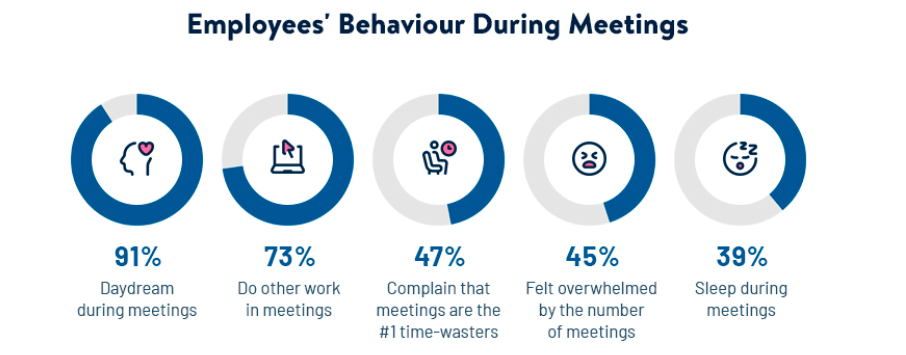The reality is that most companies are having a lot of bad meetings. Pointless meetings occur so frequently that it’s predicted they cost the US upwards of $400 billion in lost labor hours per year. While some of this wasted time can be recovered with good meeting strategies, sometimes it’s the meeting format itself that’s letting people down.
A great example of this is that over two-thirds of employees state that they don’t need to be in the majority of meetings they have. When your company hosts departmental meetings, regular team meetings, or daily catch-up sessions, meetings quickly become overly tedious. To overcome this commonality, you need to switch things up and create meetings with intention.
In this article, we’ll dive into everything you need to know about the format of office meetings. We’ll discuss structure, time commitments, and strategies to run effective meetings.
Let’s dive in.
What types of office meetings are there?
Office meetings come in many types and formats. Depending on your role, the department you work in, and your company culture, your common meeting formats can radically change.
As to not overwhelm you with thousands of distractions, we’ve distilled down the most common office meeting formats. These types of meetings are those that you and your employees will typically run into during any given week:
- 1:1 Meeting – One-on-one meetings are typically between a manager and one of their employees. This is a good time to go through a progress review, check in on an employee, and ensure they’re supported mentally while at work.
- Project Meeting – Project meetings are where teams come together to discuss goals, developments, and actions related to a specific project. These will only involve those that are participating in that project.
- Daily Scrum – Especially popular in software development teams, a daily scrum or daily standup is where everyone comes together to share what they’re working on that day. These are the shortest of all meetings and should only take a few minutes.
- Brainstorming – If you need to get the ball rolling, many managers will call a brainstorming meeting where lots of team members share their ideas. These meetings typically have one specific problem or focus to overcome.
- Team-Building – A team-building meeting allows groups to build cohesion and improve how they work together. While these used to be much more popular (we’re thinking of corporate team-building exercises), they are less common in the modern age.
- Progress Meetings – Progress meetings could technically fall into the project meeting tab. These meetings are short and will typically discuss how a specific project is developing.
While non-exhaustive, these meeting formats are a good place to start. By shifting away from large departmental meetings and instead pinpointing the exact meeting you need for a scenario, you’ll have fewer unnecessary staff.
Always select the correct type of meeting based on the objective you have. Do you want to develop ideas, share information, or support your employees? Start with the goal and then work backward to the correct office meeting format.
How do I ensure office meetings end on time?
Nothing annoys employees more than a meeting that ends late. Not only does this cause employees to arrive at other commitments late, but it also means that you poorly managed the meeting and probably misused your time. The optimal length of a meeting is only 15 minutes, with the average attention span lasting about 18 minutes.
If 15 minutes seems short to you, turn to your employees and ask what they think. If they can submit anonymous comments about your meeting style, strategy, and length, you might have some nasty realisations on your horizon.
The best way to ensure you end on time is to meticulous plan. Providing a detailed agenda can cut down the time your meeting takes. Over one meeting, one week, or even a whole year, this represents a huge amount of time that you can save. When you have topics and talking points clearly planned, you can fly through your meeting with time to spare.
Office meeting etiquette: what rules should my meetings follow?
Depending on the meeting format you choose, the guidelines of what it should include will vary. With that in mind, it’s important to have a flexible approach when creating and hosting meetings. Just make sure that you’re clear about why you’re hosting that meeting and the reasons behind inviting certain people.
Here are some general office meeting etiquette rules to follow:
- Only invite those that need to be there
- Use agendas, or don’t bother hosting the meeting
- Work out why you’re inviting each employee
- Finish with action items
- Give everyone a fair platform to speak
- Find a designated space for the meeting like a private room or multi-person office pod.
By focusing on creating a small and fluid meeting, you’re able to get the best from your employees without wasting anyone’s time.
Final Thoughts
The format of an office meeting will vary depending on the core purpose of the meeting. If you’re there to discuss employee progress, that’s probably a conversation that you should have 1:1. Alternatively, if you’re talking about project developments, then your entire team should be present. Knowing which office meeting format is the best for certain situations will help you create effective meeting plans.
Over time, and with the tips on this list, you’ll be able to refine every format of office meetings and make great meetings second nature to you and your team. Trust us, with bad meetings being a top employee concern, absolutely everyone will thank you for getting this right.


